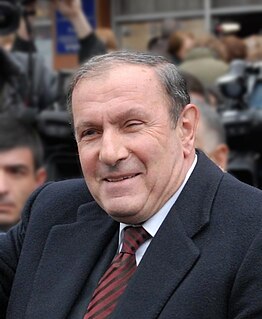
Parliamentary elections were held in Iran on 8 March 1996, with a second round on 19 April. The Combatant Clergy Association and its allies emerged as the largest bloc in the Majlis, winning 110 of the 270 seats.

Constituent Assembly elections were held in the Democratic Republic of Georgia between 14 and 16 February 1919. The electoral system used was party-list proportional representation using the D'Hondt method in a single nationwide district. The result was a victory for the Social Democratic Labour Party of Georgia, which won 81% of the vote, and 109 of the 130 seats. In by-elections held in spring, they lost four seats and the Armenian Party in Georgia - Dashnaktsitiuni and the Georgian National Party both won seats.

Presidential elections were held in Armenia on 16 March 1998, with a second round on 30 March. The result was a victory for independent candidate Robert Kocharyan, who won 58.9% of the vote in the second round. Turnout was 63.5% in the first round and 68.1% in the second.

Presidential elections were held in Armenia on 22 September 1996. The result was a victory for Levon Ter-Petrosyan, who won 51.3% of the vote. Turnout was 60.3%.

General elections were held in Turkey on 21 July 1946, the first multi-party elections in the country's history. The multiple non-transferable vote electoral system was used. The result was a victory for the Republican People's Party, which won 395 of the 465 seats.
General elections were held in Lebanon between 16 and 30 April 1972. Independent candidates won the majority of seats, although most of them were considered members of various blocs. Voter turnout was 54.4%.
General elections were held in Lebanon between 23 August and 11 October 1992, the first since 1972. Independent candidates won the majority of seats, although most of them were considered members of various blocs. Voter turnout was 30.3%.
General elections were held in Lebanon between 18 August and 15 September 1996. Independent candidates won the majority of seats, although most of them were considered members of various blocs. Voter turnout was 43.3%.

An independence referendum was held in the Republic of Armenia on 21 September 1991, and was to determine if voters were in favour of independence from the Soviet Union. A total of 99.5% of voters voted in favour. Turnout was 95.0%.

A constitutional referendum was held in Armenia on 5 July 1995. The changes to the constitution were approved by 70.3% of voters, with a turnout of 55.6%.

Parliamentary elections were held in Armenia on 20 May 1990, although further rounds were held on 3 June and 15 July due to low turnouts invalidating earlier results and by 21 July 64 seats were still unfilled, with 16 still unfilled in February the following year. The result was a victory for the Communist Party of Armenia, which won 136 of the 259 seats. The remaining candidates were all officially independents, but almost all were members of the Pan-Armenian National Movement. Overall voter turnout was 60.2%.

Parliamentary elections were held in Armenia on 5 July 1995, with a second round on 29 July. There were 150 constituency seats and 40 elected on a national basis using proportional representation. The result was a victory for the Republican Bloc, which won 88 of the 190 seats. Overall voter turnout was 54.3%.

Parliamentary elections were held in Armenia on 30 May 1999. There were 75 constituency seats and 56 elected on a national basis using proportional representation. The result was a victory for the Unity Bloc, which won 62 of the 131 seats. Overall voter turnout was 51.7%.

Presidential elections were held for the first time in Armenia on 17 October 1991. The result was a victory for Levon Ter-Petrossian, who won 83% of the vote. Turnout was 70%.
Folketing elections were held in Denmark on 7 June 1864. The National Liberal Party emerged as the largest faction, winning 40 of the 101 seats. Following the elections, Christian Albrecht Bluhme became Prime Minister on 7 July.
The first Folketing elections were held in Denmark on 4 December 1849. Adam Wilhelm Moltke remained Prime Minister after the elections.
Folketing elections were held in Denmark on 14 June 1855 in order to approve amendments to the constitution. Peter Georg Bang remained Prime Minister following the elections.
Folketing elections were held in Denmark on 14 June 1858. Carl Christian Hall remained Prime Minister following the elections.
Folketing elections were held in Denmark on 14 June 1861. Carl Christian Hall remained Prime Minister following the elections.
Folketing elections were held in Denmark on 14 November 1873. The result was a narrow victory for the Højre Coalition, which won 51 of the 101 seats. Ludvig Holstein-Holsteinborg remained Prime Minister following the elections.








